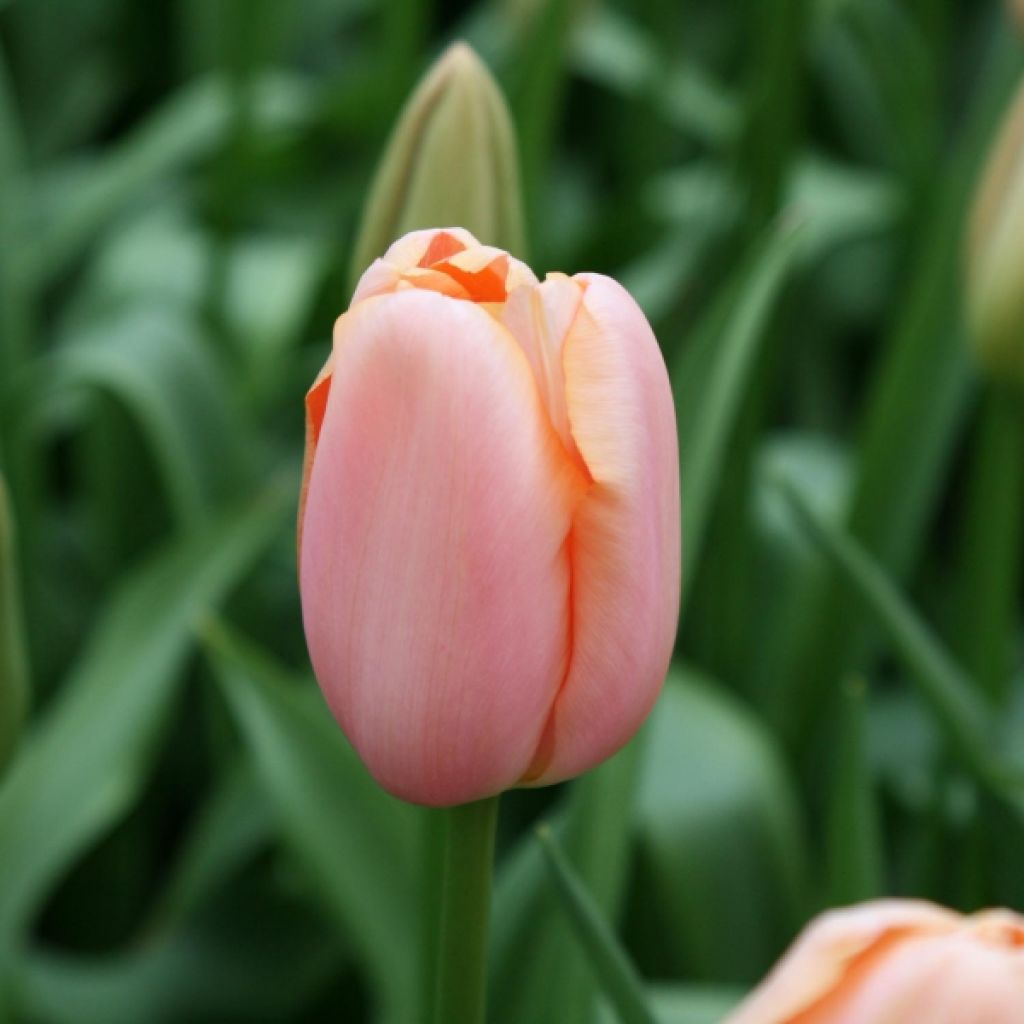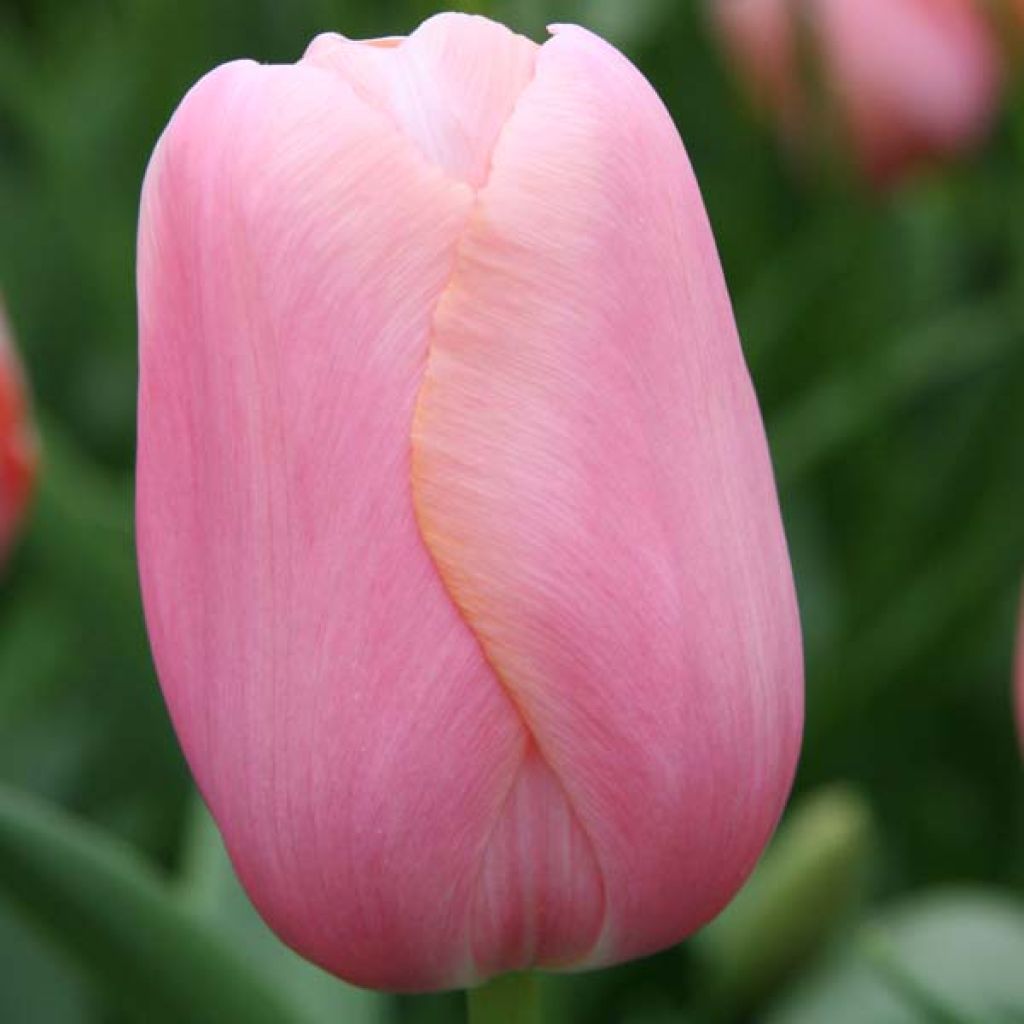

Tulipa Menton - Early simple Tulip


Tulipa Menton - Early simple Tulip
Tulipa Menton - Early simple Tulip
Tulipa Menton
Tulip
Healthy and well-packed bulb. The leaves have all emerged now, looking forward to the tulips flowering!
Laurine, 31/03/2021
This plant carries a 6 months recovery warranty
More information
We guarantee the quality of our plants for a full growing cycle, and will replace at our expense any plant that fails to recover under normal climatic and planting conditions.
From €5.90 for pickup delivery and €6.90 for home delivery
Express home delivery from €8.90.


Does this plant fit my garden?
Set up your Plantfit profile →
Description
The 'Menton' Tulip is sought after for its nuanced colour, both soft and warm, which is not common among tulips. Carried by a long and sturdy stem, this majestic flower, with an oval corolla, offers satin petals ranging from true pink to salmon pink bordered with orange under the sun. It pairs beautifully with airy roses and fuchsias.
The 'Menton' Tulip, introduced in 1971, belongs to the Liliaceae family. This superb variety has been awarded by the Royal Horticultural Society for its ornamental qualities and performance in the garden. Originally horticultural in origin, it is currently classified in the group of 'late singles' or Division 5, which flower at the end of the tulip season in May-June, making them very useful in the garden to accompany the first summer flowers. It is a seedling of the famous 'Renown' tulip. This tall tulip reaches a height of 50 to 60 cm (20 to 24in) when in bloom.
Perched on stems well above the widely lanceolate leaves of a green-grey shade, the flowers are large, thick, elegant, and iridescent, with their tone changing with the light. The foliage dries up and disappears a few weeks after flowering, while the bulb goes into dormancy.
The late single tulip 'Menton', like all its sisters, has a unique charm in the garden, in the company of forget-me-nots, daisies, mignonettes, centaureas, etc. It finds its place in large beds, alongside perennials like peonies or pastel-toned sweet Williams. They also help extend the flowering duration of the beds. It can also be planted in borders, rockeries, flower beds, as well as in pots and containers. It is ideal for creating elegant bouquets. In a vase, only use a very small amount of water. Additionally, if your tulips open too quickly, you can add two or three ice cubes to the vase every day.
When designing your beds, don't forget to consider the height and flowering period, as these parameters vary significantly from one cultivar to another. It is wise to plant a few more bulbs for cutting, as they are beautiful and last a long time in a vase.
Report an error about the product description
Plant habit
Flowering
Foliage
Botanical data
Tulipa
Menton
Liliaceae
Tulip
Cultivar or hybrid
Planting and care
Plant Tulip bulbs in the autumn, from September to December, at a depth of 15 cm (6in), spacing them 10 cm (4in) apart. The planting should be done in ordinary soil, slightly acidic, neutral, or slightly alkaline, loose, well-worked and well-drained. Never add manure or poorly decomposed compost to the planting soil, as this could cause the bulbs to rot. The Triumph Tulip will thrive in moist to dry soil. Plant it in a sunny or lightly shaded location. After flowering, the foliage becomes unsightly, so we recommend planting heucheras, tiarellas, brunneras, bleeding hearts, or euphorbias in the foreground of your flower beds. Their foliage will enhance the colours of your tulips and, as the season progresses, elegantly hide their yellowing leaves. Once the flowering is over, it is best to remove the fruits to avoid exhausting the plant. Allow the leaves to completely dry before cutting them.
Planting period
Intended location
Care
-
, onOrder confirmed
Reply from on Promesse de fleurs
Haven't found what you were looking for?
Hardiness is the lowest winter temperature a plant can endure without suffering serious damage or even dying. However, hardiness is affected by location (a sheltered area, such as a patio), protection (winter cover) and soil type (hardiness is improved by well-drained soil).

Photo Sharing Terms & Conditions
In order to encourage gardeners to interact and share their experiences, Promesse de fleurs offers various media enabling content to be uploaded onto its Site - in particular via the ‘Photo sharing’ module.
The User agrees to refrain from:
- Posting any content that is illegal, prejudicial, insulting, racist, inciteful to hatred, revisionist, contrary to public decency, that infringes on privacy or on the privacy rights of third parties, in particular the publicity rights of persons and goods, intellectual property rights, or the right to privacy.
- Submitting content on behalf of a third party;
- Impersonate the identity of a third party and/or publish any personal information about a third party;
In general, the User undertakes to refrain from any unethical behaviour.
All Content (in particular text, comments, files, images, photos, videos, creative works, etc.), which may be subject to property or intellectual property rights, image or other private rights, shall remain the property of the User, subject to the limited rights granted by the terms of the licence granted by Promesse de fleurs as stated below. Users are at liberty to publish or not to publish such Content on the Site, notably via the ‘Photo Sharing’ facility, and accept that this Content shall be made public and freely accessible, notably on the Internet.
Users further acknowledge, undertake to have ,and guarantee that they hold all necessary rights and permissions to publish such material on the Site, in particular with regard to the legislation in force pertaining to any privacy, property, intellectual property, image, or contractual rights, or rights of any other nature. By publishing such Content on the Site, Users acknowledge accepting full liability as publishers of the Content within the meaning of the law, and grant Promesse de fleurs, free of charge, an inclusive, worldwide licence for the said Content for the entire duration of its publication, including all reproduction, representation, up/downloading, displaying, performing, transmission, and storage rights.
Users also grant permission for their name to be linked to the Content and accept that this link may not always be made available.
By engaging in posting material, Users consent to their Content becoming automatically accessible on the Internet, in particular on other sites and/or blogs and/or web pages of the Promesse de fleurs site, including in particular social pages and the Promesse de fleurs catalogue.
Users may secure the removal of entrusted content free of charge by issuing a simple request via our contact form.
The flowering period indicated on our website applies to countries and regions located in USDA zone 8 (France, the United Kingdom, Ireland, the Netherlands, etc.)
It will vary according to where you live:
- In zones 9 to 10 (Italy, Spain, Greece, etc.), flowering will occur about 2 to 4 weeks earlier.
- In zones 6 to 7 (Germany, Poland, Slovenia, and lower mountainous regions), flowering will be delayed by 2 to 3 weeks.
- In zone 5 (Central Europe, Scandinavia), blooming will be delayed by 3 to 5 weeks.
In temperate climates, pruning of spring-flowering shrubs (forsythia, spireas, etc.) should be done just after flowering.
Pruning of summer-flowering shrubs (Indian Lilac, Perovskia, etc.) can be done in winter or spring.
In cold regions as well as with frost-sensitive plants, avoid pruning too early when severe frosts may still occur.
The planting period indicated on our website applies to countries and regions located in USDA zone 8 (France, United Kingdom, Ireland, Netherlands).
It will vary according to where you live:
- In Mediterranean zones (Marseille, Madrid, Milan, etc.), autumn and winter are the best planting periods.
- In continental zones (Strasbourg, Munich, Vienna, etc.), delay planting by 2 to 3 weeks in spring and bring it forward by 2 to 4 weeks in autumn.
- In mountainous regions (the Alps, Pyrenees, Carpathians, etc.), it is best to plant in late spring (May-June) or late summer (August-September).
The harvesting period indicated on our website applies to countries and regions in USDA zone 8 (France, England, Ireland, the Netherlands).
In colder areas (Scandinavia, Poland, Austria...) fruit and vegetable harvests are likely to be delayed by 3-4 weeks.
In warmer areas (Italy, Spain, Greece, etc.), harvesting will probably take place earlier, depending on weather conditions.
The sowing periods indicated on our website apply to countries and regions within USDA Zone 8 (France, UK, Ireland, Netherlands).
In colder areas (Scandinavia, Poland, Austria...), delay any outdoor sowing by 3-4 weeks, or sow under glass.
In warmer climes (Italy, Spain, Greece, etc.), bring outdoor sowing forward by a few weeks.


































